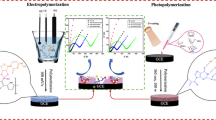Abstract
Gold electrodes were chemically modified with a phosphate ester monolayer designed to mimic biological ion-channel membranes. Cyclic voltammograms of Fe(CN)6 3− as electroactive marker were measured in the presence of various types of analyte cations. Whereas in the absence of analyte cations the marker reduction was hindered by electrostatic repulsion between the marker anions and phosphate groups of the receptor monolayer, binding of di-and trications to the monolayer resulted in large increases of the reduction current. Trivalent cations could be detected down to the submicromolar concentration range with excellent selectivities over alkali metal ions. Also divalent cations were well discriminated and similar responses as to trivalent cations were only observed if their concentration exceeded that of the trivalent cations by about two orders of magnitudes.
Similar content being viewed by others
Author information
Authors and Affiliations
Additional information
Received August 24, 1998. Revision March 10, 1999.
Rights and permissions
About this article
Cite this article
Takaya, M., Bühlmann, P. & Umezawa, Y. Ion-Channel – Mimetic Sensors Based on Self-Assembled Monolayers of Phosphate Esters: High Selectivity for Trivalent Cations. Mikrochim Acta 132, 55–60 (1999). https://doi.org/10.1007/PL00010073
Issue Date:
DOI: https://doi.org/10.1007/PL00010073




